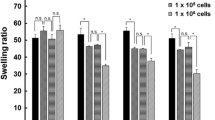Summary
Remodeling of extracellular matrix involves a number of steps including the recruitment, accumulation, and eventual apoptosis of parenchymal cells as well as the production, organization, and rearrangement of extracellular matrix produced by these cells. The culture of fibroblasts in three-dimensional gels made of type I collagen has been used as a model of tissue contraction which characterizes both wound repair and fibrosis. The current study was designed to determine the effect of initial collagen concentration on the ability of fibroblasts to contract collagen gels and on cell survival. Native type I collagen was extracted from rat tail tendons and used to prepare collagen gels with varying collagen concentration (0.75–2.0 mg/ml). Human lung fibroblasts (HFL-1) were cast into the gels and cultured in Dulbecco modified Eagle medium with 0.1% fetal calf serum for 2 wk. The gel size, collagen content, and deoxyribonucleic acid (DNA) content were determined. Gels prepared with an initial concentration of 0.75 mg/ml contracted more rapidly and to a smaller final size than gels prepared from 2 mg/ml initial collagen concentration (final size 7.1 versus 36.4% of initial size, P <0.01). There was no significant degradation of the collagen in the gels under either condition. Hence, the dramatically increased contraction of the lower density gels resulted in a higher final density (P<0.01). Cell density was estimated from DNA content. In low initial density gels, the final DNA content was significantly less than that in higher initial density gels (0.73 versus 1.88 μg/gel, P<0.05). This was accompanied by an increased percentage of apoptotic cells at day 14 (43.3 versus 34.1%, P<0.05). If the gels were maintained in the attached state which largely prevents contraction, apoptosis was significantly reduced, suggesting that contraction rather than matrix composition was a requirement for the increased apoptosis. In summary, these findings indicate that the initial matrix composition can lead to differing outcomes during fibroblast-mediated wound contraction.
Similar content being viewed by others
References
Bell, E.; Ivarsson, B.; Merrill, C. Production of a tissue-like structure by contraction of collagen lattices by human fibroblasts of different proliferative potential in vitro. Proc. Natl. Acad. Sci. USA 76:1274–1278; 1979.
Bergman, I.; Loxley, R. Two improved and simplified methods for the spectrophotometric determination of hydroxyproline. Anal. Chem. 35:1961–1965; 1963.
Brewster, C. E.; Horwarth, P. H.; Djukanovic, R.; Wilson, J.; Holgate, S. T.; Roche, W. R. Myofibroblasts and subepithelial fibrosis in bronchial asthma. Am. J. Respir. Cell. Mol. Biol. 3:507–511; 1990.
Chen, C. S.; Mrksich, M.; Huang, S.; Whitesides, G. M.; Ingber, D. E. Geometric control of cell life and death. Science 276:1425–1428; 1997.
Edwards, C. A.; O'Brien, W. D. Modified assay for determinaton of hydroxy-proline in a tissue hydrolyzate. Clin. Chim. Acta 104:161–167; 1980.
Elsdale, T.; Bard, J. Collagen substrata for studies on cell behavior. J. Cell. Biol. 54:626–637; 1972.
Gavrieli, Y.; Sherman, Y.; Sasson, S. A. Identification of programmed cell death in situ via specific labeling of nuclear DNA fragmentation. J. Cell Biol. 119:493–501; 1992.
Goldberg, G. I.; Wilhelm, S. M.; Kronberger, A. Human fibroblast collagenase: complete primary structure and homology to an oncogene transformation-induced rat protein. J. Biol. Chem. 261:6600–6605; 1986.
Grinnell, F. Fibroblasts, myofibroblasts and wound contraction. J Cell Biol. 124:401–404; 1994.
Grinnell, F.; Zhu, M.; Carlson, M. A.; Abrams, J. M. Release of mechanical tension triggers apoptosis of human fibroblasts in a model of regressing granulation tissue. Exp. Cell. Res. 248:608–619; 1999.
Guidry, C.; Grinnell, F. Contraction of hydrated collagen gels by fibroblasts: evidence for two mechanisms by which collagen fibrils are stabilized. Collagen Rel. Res. 61:515–529; 1986.
Labarca, C.; Paigen, K. A simple, rapid and sensitive DNA assay procedure. Anal. Biochem. 102:344–352; 1980.
Laemmli, U., Cleavage of structural proteins during the assembly of the head of bacteriophage T4. Nature 227:680–685; 1970.
Mio, T.; Adachi, Y.; Romberger, D. J.; Ertl, R. F.; Rennard, S. I. Regulation of fibroblast proliferation in three dimensional collagen gel matrix. In Vitro Cell. Dev. Biol. 32:427–433; 1996.
Roche, W. R.; Beasley, R.; Williams, J. H.; Holgate, S. T. Subepithelial fibrosis in the bronchi of asthmatics. Lancet 1:520–524; 1989.
Rompre, P.; Auger F. A.; Germain, L.; Bouvard, V.; Lopez Valle, C. A.; Thibault, J.; LeDuy, A. Influence of initial collagen and cellular concentrations on the final surface area of dermal and skin equivalents: A box-behnken analysis. In Vitro Cell. Dev. Biol. 26:983–990; 1990.
Ruoslahti, E. Stretching is good for a cell. Science 276:1345–1346; 1997.
Welgus, H. G.; Jeffrey, J. J.; Eisen A. Z. The collagen substrate specificity of human skin fibroblast collagenase. J. Biol. Chem. 256:9511–9515; 1981.
Author information
Authors and Affiliations
Corresponding author
Rights and permissions
About this article
Cite this article
Zhu, Y.K., Umino, T., Liu, X.D. et al. Contraction of fibroblast-containing collagen gels: Initial collagen concentration regulates the degree of contraction and cell survival. In Vitro Cell.Dev.Biol.-Animal 37, 10–16 (2001). https://doi.org/10.1290/1071-2690(2001)037<0010:COFCCG>2.0.CO;2
Received:
Accepted:
Issue Date:
DOI: https://doi.org/10.1290/1071-2690(2001)037<0010:COFCCG>2.0.CO;2




